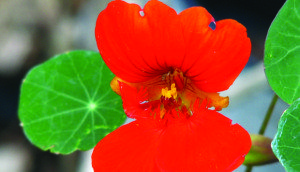Simple Techniques to Bring Edible Flowers to the Table
The culinary use of flowers goes back centuries, but has taken center stage in haute cuisine in recent years. Edible flowers are not only pretty, but many are praised for their health benefits. With a little planning, we can master some simple techniques that will delight family and friends the next time you make dinner.
Calendula (also referred to a pot marigold) has a long history as a medicinal herb, and its peppery blossoms add a spicy kick to many dishes. Calendula was used for medicinal purposes during the Civil War and World War I, when its flowers were used to dress soldiers’ wounds to control bleeding and function as an antiseptic. Calendula extracts have also been used to treat acne, and it has been used in tea form to help ease abdominal cramps and soothe
ulcers. This orange-yellow colored flower is high in flavonoids (reduce free radicals in body) and includes vitamin C and carotenoids.
The easiest way to incorporate Calendula in the kitchen is to add the petals as a garnish for a tiny splash of color. The petals can also be added to a simple salad or can mixed with oil and vinegar for a dressing. Calendula‘s vibrant petals have also been used over the centuries as a coloring agent for butter and cheese and were once used as a dye for fabrics. Today’s chefs might mix the golden orange flower petals into white rice or a vanilla ice cream to change the color without changing its flavor.
 Nasturtium is another edible flower with blossoms that have been described as slightly sweet, spicy, bitter and similar to watercress. Nasturtium claims a concentration of vitamin C and natural antibiotic properties among its health benefits.
Nasturtium is another edible flower with blossoms that have been described as slightly sweet, spicy, bitter and similar to watercress. Nasturtium claims a concentration of vitamin C and natural antibiotic properties among its health benefits.
Like calendula, it can be used to add a spicy touch to a salad or infuse color into a salad dressing. Some chefs add nasturtiums to pizza as an uncooked topping or as an edible garnish to guacamole and Mexican dishes. For a beautiful sunset-colored cocktail, nasturtium blossoms can be added to a simple syrup of sugar and water, and mixed with sparkling water and alcohol if desired. The entire nasturtium plant is edible and the green seeds can be used as a replacement for peppercorns and capers or combined with cream cheese or butter for flavorful spreads.
As with most foods, a note of caution must be used when caring for and preparing edible flowers. Never use pesticides or other chemicals on any part of any plant that produces blossoms, eat in moderation and research all health risks if pregnant. Be sure to rinse, dry and consume these fragile flowers as quickly as possible after harvesting.
The luxury of a creatively presented meal need not be limited to restaurants because we can prepare edible flower creations in our own home with minimal effort. So enjoy the splendor of nature as flowers grow outside, and celebrate their nutritional value, versatility and beauty as they make their way to our plates.
Kenny Baldo is a garden consultant at Yard2Kitchen Organic Gardens, which offers an edible flower planter perimeter with all of their organic vegetable gardens. For a complimentary consultation, call 732-410-6173. For more information, visit Yard2Kitchen.com.





























